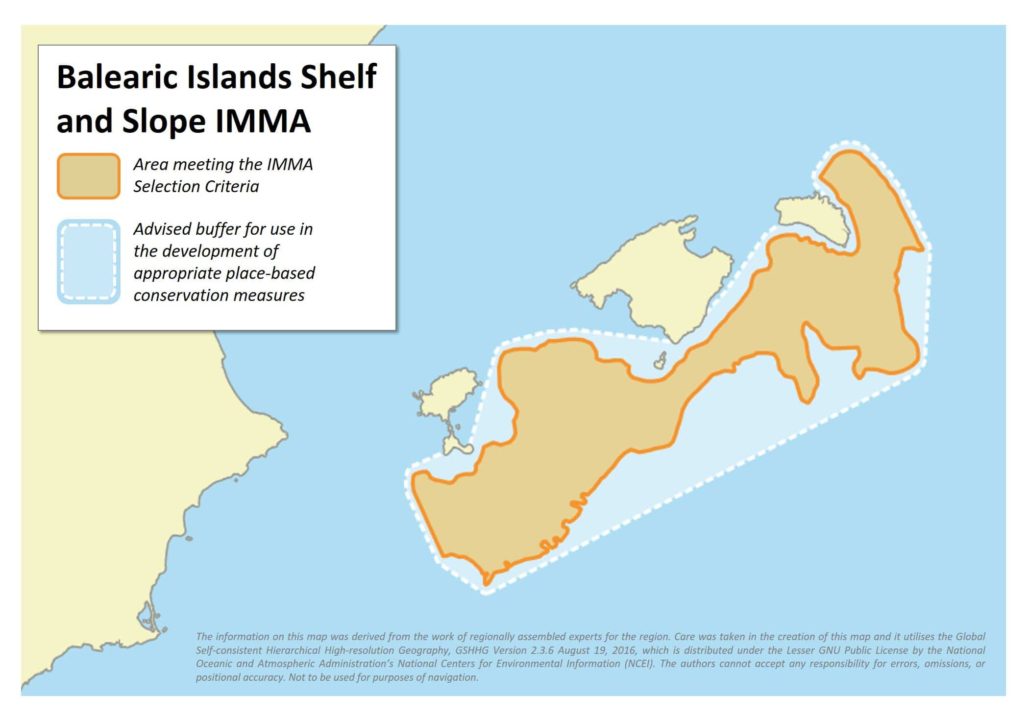Balearic Islands Shelf and Slope IMMA
Area Size
22 708 km2
Qualifying Species and Criteria
Sperm whale – Physeter macrocephalus
Criterion A; C (1, 2)
Marine Mammal Diversity
Stenella coeruleoalba, Tursiops truncatus, Grampus griseus, Globicephala melas, Delphinus delphis
Download brochure
Summary
The deep-water shelf and slope areas of the eastern Balearic archipelago contain a high density of Mediterranean sperm whales (Physeter macrocephalus). Both social units and mature males are consistently observed here. This ecologically important area thus also has an important role as one of the known breeding grounds for the species in the Mediterranean. The species is distributed from the deeper continental shelf to waters of 2000-2500m depth. The Mediterranean sperm whale subpopulation is Endangered and is threatened in the area mainly by net entanglement and ship strikes.
Description of Qualifying Criteria
Criterion A – Species or Population Vulnerability
The IUCN Red List classifies the Mediterranean subpopulation of sperm whale as Endangered and infers that their numbers are declining from significant anthropogenic threats. These whales are likely to be genetically isolated from the Atlantic population. The principal threats are from ship strikes and entanglement in driftnets, followed by ingestion of plastic debris, anthropogenic noise, chemical pollution, and disturbance by poorly managed whale watching operations.
Criterion C: Key Life Cycle Activities
Sub-criterion C1: Reproductive Areas
The area is one of the few regions in the western Mediterranean basin in which sperm whale social groups and singleton males are both sighted regularly – indicating it is an important area for contact between mature males and reproductive females. Calves are also regularly sighted within female groups.
Sub-criterion C2: Feeding Areas
Bathymetric features and the hydrodynamic processes in the area act to concentrate prey for sperm whales and evidence suggests that the south-face continental shelf slopes are an important foraging habitat for this population. Acoustic data confirm the activity of feeding. Sperm whales in the area concentrate in areas where the bottom aspect is approximately between 0° and 210°, i.e. where the shelf wall is oriented north-eastward, eastward or southward. Depth might be associated with the bathymetric zonation of cephalopod assemblages, while slope aspect likely interacts with north-flowing Atlantic water drawn by the Balearic Current to determine the downwelling/upwelling movements that are believed to influence the availability and concentration of sperm whale prey.
Supporting Information
Brotons, J.M., Grau., A.M. & Rendell., L. 2008a, Estimating the impact of interactions between bottlenose dolphins and artisanal fisheries around the Balearic Islands. Marine Mammal Science, vol 24, no. 1, pp. 112-127.
Brotons, J.M., Munilla., Z., Grau., A.M. & Rendell., L. 2008b, Do pingers reduce interactions between bottlenose dolphins and nets around the Balearic Islands? Endangered Species Research, vol 5, no. 2-3, pp. 301-308.
Carpinelli, E., Gauffier, P., Verborgh, P., Airoldi, S., David, L., Di-Méglio, N., Cañadas, A., Frantzis, A., Rendell, L., Lewis, T., Mussi, B., Pace, D.S., de Stephanis. R. 2014. Assessing sperm whale (Physeter macrocephalus) movements within the Mediterranean Sea through photo-identification, Aquatic Conservation: Marine and Freshwater Ecosystems (special issue) 24, Suppl (1): 23-30
Drouot, V., Gannier, A., Goold, J.C., 2004b. Summer social distribution of sperm whales (Physeter macrocephalus) in the Mediterranean Sea. J. Mar. Biol. Assoc. UK 84, 675–680.
Gonzalvo, J., Forcada, J., Grau, E., & Aguilar, A. 2014. Strong site-fidelity increases vulnerability of common bottlenose dolphins Tursiops truncatus in a mass tourism destination in the western Mediterranean Sea. Journal of the Marine Biological Association of the United Kingdom,94(6), 1227-1235.
Gonzalvo, J., Valls, M., Cardona, L., Aguilar, A., 2008. Factors determining the interaction between common bottlenose dolphins and bottom trawlers off the Balearic Archipelago (western Mediterranean Sea), Journal of Experimental Marine Biology and Ecology, 367: 47-52.
Lewis, T., Boisseau, O., Danbolt, M., Gillespie, D., Lacey, C., Leaper, R., Matthews, J. McLanaghan, R., Moscrop, A. Submitted. Abundance estimates for sperm whales in the Mediterranean Sea from acoustic line-transect surveys. Journal of Cetacean Research and Management.
Notarbartolo-di-Sciara, G. 2014. Sperm whales, Physeter macrocephalus, in the Mediterranean Sea: a summary of status, threats, and conservation recommendations. Aquat. Conserv. Mar. Freshw. Ecosyst. 24(S1): 4-10.
Pirotta, E., Matthiopoulos, J., MacKenzie, M., Scott-Hayward, L., Rendell, L. 2011. Modelling sperm whale habitat preference: A novel approach combining transect and follow data. Marine Ecology Progress Series. 436: 257-272
Praca, E., Gannier, A., Das, K., Laran, S. 2009. Modelling the habitat suitability of cetaceans: example of the sperm whale in the northwestern Mediterranean Sea. Deep-Sea Res. 56, 648-657.
Reeves, R. and Notarbartolo di Sciara, G. 2006. The status and distribution of cetaceans in the Black Sea and Mediterranean Sea. IUCN Centre for Mediterranean Cooperation, Malaga, Spain. 137 pp.
Rendell, L., Frantzis, A., 2016. Mediterranean sperm whales, Physeter macrocephalus: The precarious state of a lost tribe, in: Notarbartolo di Sciara, G., Podesta, M., Curry, B.E. (Eds.), Mediterranean Marine Mammals Ecology and Conservation. Adv. Mar. Biol. 75, Elsevier, pp. 37-74.
Rendell, L., Simiao, S., Brontos, J.M., Airoldi, S., Fasano, D., Gannier, A. 2014. Abundance and movements of sperm whales in the western Mediterranean basin. Aquatic Conserv Mar. Freshw. Ecosyst. 24, 1, 23-30.
Downloads
Download the full account of the Balearic Islands Shelf and Slope IMMA using the Fact Sheet button below:
To make a request to download the GIS Layer (shapefile) for the Balearic Islands Shelf and Slope IMMA please complete the following Contact Form:


